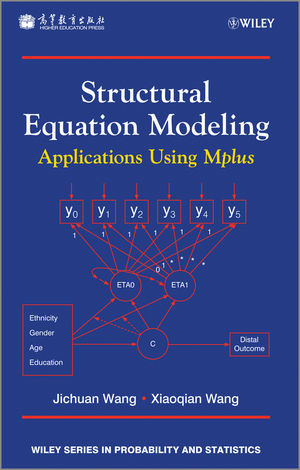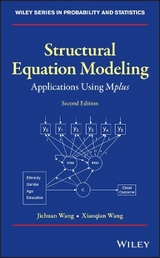
Structural Equation Modeling
John Wiley & Sons Inc (Verlag)
978-1-119-97829-9 (ISBN)
- Titel ist leider vergriffen;
keine Neuauflage - Artikel merken
A reference guide for applications of SEM using Mplus Structural Equation Modeling: Applications Using Mplus is intended as both a teaching resource and a reference guide. Written in non-mathematical terms, this book focuses on the conceptual and practical aspects of Structural Equation Modeling (SEM). Basic concepts and examples of various SEM models are demonstrated along with recently developed advanced methods, such as mixture modeling and model-based power analysis and sample size estimate for SEM. The statistical modeling program, Mplus, is also featured and provides researchers with a flexible tool to analyze their data with an easy-to-use interface and graphical displays of data and analysis results. Key features: * Presents a useful reference guide for applications of SEM whilst systematically demonstrating various advanced SEM models, such as multi-group and mixture models using Mplus. * Discusses and demonstrates various SEM models using both cross-sectional and longitudinal data with both continuous and categorical outcomes. * Provides step-by-step instructions of model specification and estimation, as well as detail interpretation of Mplus results.
* Explores different methods for sample size estimate and statistical power analysis for SEM. By following the examples provided in this book, readers will be able to build their own SEM models using Mplus. Teachers, graduate students, and researchers in social sciences and health studies will also benefit from this book.
Jichuan Wang, Children s National Medical Center, The George Washington University, USA Xiaoqian Wang, Mobley Group Pacific Ltd., P.R. China
Preface ix 1 Introduction 1 1.1 Model formulation 2 1.1.1 Measurement model 4 1.1.2 Structural model 6 1.1.3 Model formulation in equations 7 1.2 Model identification 11 1.3 Model estimation 14 1.4 Model evaluation 17 1.5 Model modification 23 1.6 Computer programs for SEM 24 Appendix 1.A Expressing variances and covariances among observed variables as functions of model parameters 25 Appendix 1.B Maximum likelihood function for SEM 27 2 Confirmatory factor analysis 29 2.1 Basics of CFA model 30 2.2 CFA model with continuous indicators 42 2.3 CFA model with non-normal and censored continuous indicators 58 2.3.1 Testing non-normality 58 2.3.2 CFA model with non-normal indicators 59 2.3.3 CFA model with censored data 65 2.4 CFA model with categorical indicators 68 2.4.1 CFA model with binary indicators 69 2.4.2 CFA model with ordered categorical indicators 77 2.5 Higher order CFA model 78 Appendix 2.A BSI-18 instrument 86 Appendix 2.B Item reliability 86 Appendix 2.C Cronbach s alpha coefficient 88 Appendix 2.D Calculating probabilities using PROBIT regression coefficients 88 3 Structural equations with latent variables 90 3.1 MIMIC model 90 3.2 Structural equation model 119 3.3 Correcting for measurement errors in single indicator variables 130 3.4 Testing interactions involving latent variables 134 Appendix 3.A Influence of measurement errors 139 4 Latent growth models for longitudinal data analysis 141 4.1 Linear LGM 142 4.2 Nonlinear LGM 157 4.3 Multi-process LGM 183 4.4 Two-part LGM 188 4.5 LGM with categorical outcomes 196 5 Multi-group modeling 207 5.1 Multi-group CFA model 208 5.1.1 Multi-group first-order CFA 212 5.1.2 Multi-group second-order CFA 245 5.2 Multi-group SEM model 268 5.3 Multi-group LGM 278 6 Mixture modeling 289 6.1 LCA model 290 6.1.1 Example of LCA 296 6.1.2 Example of LCA model with covariates 309 6.2 LTA model 318 6.2.1 Example of LTA 320 6.3 Growth mixture model 340 6.3.1 Example of GMM 342 6.4 Factor mixture model 365 Appendix 6.A Including covariate in the LTA model 375 7 Sample size for structural equation modeling 391 7.1 The rules of thumb for sample size needed for SEM 391 7.2 Satorra and Saris s method for sample size estimation 393 7.2.1 Application of Satorra and Saris s method to CFA model 394 7.2.2 Application of Satorra and Saris s method to LGM 401 7.3 Monte Carlo simulation for sample size estimation 405 7.3.1 Application of Monte Carlo simulation to CFA model 406 7.3.2 Application of Monte Carlo simulation to LGM 412 7.3.3 Application of Monte Carlo simulation to LGM with covariate 415 7.3.4 Application of Monte Carlo simulation to LGM with missing values 417 7.4 Estimate sample size for SEM based on model fit indices 422 7.4.1 Application of MacCallum, Browne and Sugawara s method 423 7.4.2 Application of Kim s method 424 References 429 Index 447
| Erscheint lt. Verlag | 1.10.2012 |
|---|---|
| Reihe/Serie | Wiley Series in Probability and Statistics |
| Verlagsort | New York |
| Sprache | englisch |
| Maße | 152 x 236 mm |
| Gewicht | 832 g |
| Themenwelt | Mathematik / Informatik ► Mathematik ► Angewandte Mathematik |
| Mathematik / Informatik ► Mathematik ► Wahrscheinlichkeit / Kombinatorik | |
| ISBN-10 | 1-119-97829-7 / 1119978297 |
| ISBN-13 | 978-1-119-97829-9 / 9781119978299 |
| Zustand | Neuware |
| Haben Sie eine Frage zum Produkt? |
aus dem Bereich



